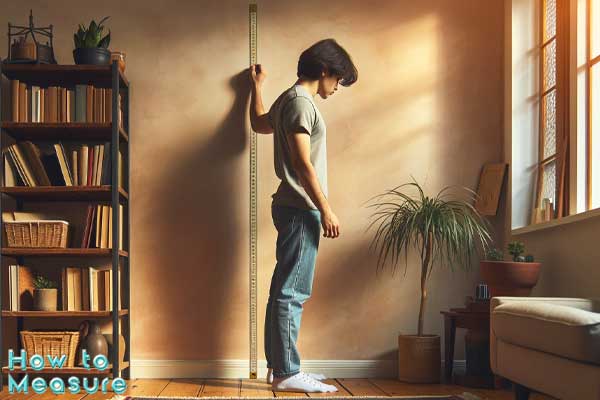Measuring one’s height at home is a surprisingly nuanced activity that most of us may need to undertake for a variety of reasons—whether it’s tracking the growth of a child, updating personal records, or monitoring health metrics such as BMI. While it may seem straightforward, ensuring accurate and consistent measurements outside a professional setting involves a bit more than just standing against a wall and marking a spot. This article will serve as your comprehensive guide to accurately measuring height at home, detailing the tools you’ll need, the techniques to employ, and the pitfalls to avoid. From preparing your space to finalizing and interpreting your measurements, we’ll cover each step to help you master the art of height measurement in the familiar comfort of your home.
Essential Tools for Home Height Measurement
Embarking on the task of measuring height at home requires a few essential tools that are easily accessible and simple to use. These tools are vital to ensure the accuracy and reliability of your measurements.
- Stadiometer or Wall-Mounted Measurer: For those seeking precision akin to that of medical professionals, a stadiometer is the gold standard. It’s a calibrated vertical ruler with a sliding horizontal rod or paddle that ensures an accurate measurement. For a more permanent solution, wall-mounted height measurers can be installed, which often come with clear markings and a fixed base.
- Tape Measure: A retractable metal tape measure is preferable as it offers rigidity necessary for precise measurement. It should be long enough to measure the full height of the person, with markings in at least millimeters or sixteenths of an inch for accuracy.
- Level Tool: This is crucial to ensure that the flat object used to mark the person’s height is perfectly horizontal. Even slight angles can skew the measurement, so a level tool can be invaluable, especially when a stadiometer is not available.
- Flat Object: A ruler, a hardcover book, or any flat, rigid object is needed to create a right angle against the wall and the top of the head. This ensures a straight line for marking the individual’s height.
- Pencil: A fine-tipped pencil is necessary for marking the spot where the flat object meets the wall. Pencil marks are precise and can easily be erased or painted over if necessary.
- Eraser or Cloth: To maintain the wall’s cleanliness, an eraser or damp cloth can be used to remove any pencil marks after measurement.
- Helper: Although not a tool, having a second person can significantly improve the ease and accuracy of the measurement process. They can ensure the level is straight, the measuring tape is taut, and that the mark is precisely made.
By assembling these tools, you can create an environment akin to that of a professional height measurement setting. With these at your disposal, you can proceed to measure your height accurately, which will be detailed in the subsequent steps of this guide.
Step-by-Step Guide to Measuring Your Height by Yourself
Measuring your own height at home without assistance can be a little tricky, but with the right approach, it’s definitely achievable. Here’s a detailed guide on how to do it:
- Preparation:
- Choose the right location: Find a flat, hard surface next to a straight wall with no baseboards. Ensure the area is well-lit so you can see clear markings.
- Setting Up:
- Place the measuring tape: Affix the start of a tape measure to the floor against the wall. If it’s not self-supporting, you may need to tape it in place to keep it from sliding.
- Standing Position:
- Stand straight: With your back to the wall, align your heels, buttocks, shoulders, and head against the wall. Stand as tall as possible with your feet flat on the ground, heels together, and your gaze forward. Your line of sight and chin should be parallel to the floor.
- Marking Your Height:
- Use a flat object: Take a small, flat object like a ruler or a hardcover book. Place it on your head, holding it horizontal to the ground. It should touch the wall at the point that aligns with the top of your head.
- Make a pencil mark: Without moving the object, carefully make a pencil mark on the wall at the underside of the object, ensuring it’s level.
- Measuring:
- Measure the height: Move away from the wall and use a tape measure to measure from the floor to the pencil mark. Be sure to look straight ahead at the tape to avoid parallax errors.
- Recording the Measurement:
- Record your height: Write down your measurement as soon as you take it. If your tape measure is in inches, record to the nearest 1/16th of an inch; if it’s in centimeters, record to the nearest millimeter.
- Double-Check:
- Verify the measurement: To ensure accuracy, repeat the measurement a couple of times. If you get the same result twice, you can be confident in its accuracy.
- Clean Up:
- Erase the mark: Use an eraser or damp cloth to clean the pencil mark from the wall.
This method requires patience and careful attention to detail. The key is to maintain a straight posture and ensure that the flat object on your head is perfectly level when you make your mark. With practice, measuring your height by yourself will become an easy and routine task.
How to Accurately Measure Your Height with a Partner’s Help
When you have a partner to assist you, measuring your height can be a more accurate and smoother process. Here’s a completely reworded guide on how to achieve a precise measurement:
Selecting the Ideal Spot:
- Positioning: Locate an uncarpeted spot against a flat wall. Ensure there’s no crown molding or baseboard to interfere with the measurement.
Pre-Measurement Setup:
- Footwear and Headgear: Remove your shoes and any hair accessories or hairstyles that might add extra height, like braids or buns.
- Clothing Considerations: Take off any bulky outer garments that could prevent you from standing flush against the wall.
Proper Stance:
- Alignment: Position yourself so that your heels, rear, shoulders, and head are all in contact with the wall. Ensure that your feet are together, flat on the ground.
- Posture: Keep your posture erect, eyes looking straight with your chin parallel to the floor, to maintain a natural stance.
Marking Technique:
- Balanced Object Placement: Have your partner hold a straight-edged object, such as a book or ruler, against the wall above your head, ensuring it remains perpendicular to the wall.
- Precision Marking: Instruct them to carefully slide the object down to your head’s highest point and then to make a light pencil mark on the wall.
Measurement Process:
- Using the Tape Measure: Have your assistant measure from the floor straight up to the mark using a rigid metal tape measure for the most precise reading.
- Recording the Measurement: Document the height immediately, rounding off to the closest 1/8th of an inch or 0.1 centimeter for precision.
Verification:
- Checking Twice: Repeat the process at least once to confirm the accuracy of the measurement.
Post-Measurement Cleanup:
- Erasing Marks: Remove the pencil mark from the wall to leave the space as it was before.
By following these detailed steps, you can ensure an accurate height measurement at home with the help of another person. It’s a straightforward process that requires a bit of preparation and care to achieve the best results.
Average Height Across Different Regions
When discussing average height, it’s important to acknowledge that these statistics can vary significantly from one country to another due to genetic, dietary, and environmental factors.
Average Height in the United States:
- Women: The typical height for adult women in the U.S. hovers around 64 inches, which is equivalent to 5 feet 4 inches.
- Men: For adult men, the average is closer to 69 inches, or 5 feet 9 inches, as per health authority data.
Global Variations in Average Height:
- In the Netherlands: This European country is known for its taller populace, with women averaging approximately 66 inches in height (5 feet 6 inches) and men standing on average at around 72 inches, nearly 6 feet tall.
Contrasts in Different Regions:
- The Philippines Example: The average stature in the Philippines tends to be shorter, with women typically just below 60 inches (5 feet) and men averaging around 64 inches (5 feet 4 inches).
These figures are a snapshot of global height averages and demonstrate the diversity in human stature worldwide. It’s also worth noting that these averages are subject to change over time due to various factors, including health, nutrition, and overall living conditions.
How to convert height in feet and inches to centimeters?
The metric system, widely used around the globe, measures length in units like meters and centimeters. However, in some countries like the United States, the imperial system is still in common use, with measurements often given in feet and inches. When one needs to convert these measurements to the metric system, a straightforward method is applied.
Here’s how to convert a height given in feet and inches to centimeters:
- Calculate Total Height in Inches: First, you need to express the height entirely in inches. If a person is 5 feet 6 inches tall, that’s a total of (5 times 12) + 6 inches, which equals 66 inches.
- Conversion Factor: Since one inch is equivalent to 2.54 centimeters, the conversion involves a simple multiplication.
- Multiply by Conversion Factor: Take the total height in inches and multiply by 2.54 to get the height in centimeters. For instance, someone who is 66 inches tall would be 66 times 2.54, which equals 167.64 centimeters.
For those who convert between these units regularly, having a conversion chart can be quite handy. Below is a quick reference chart for converting various heights from feet and inches to centimeters:
- 4 feet 6 inches = 137.16 cm
- 4 feet 7 inches = 139.7 cm
- 4 feet 8 inches = 142.24 cm
- 4 feet 9 inches = 144.78 cm
- 4 feet 10 inches = 147.32 cm
- 4 feet 11 inches = 149.86 cm
- 5 feet = 152.4 cm
- 5 feet 1 inch = 154.94 cm
- 5 feet 2 inches = 157.48 cm
- 5 feet 3 inches = 160.02 cm
- 5 feet 4 inches = 162.56 cm
- 5 feet 5 inches = 165.1 cm
- 5 feet 6 inches = 167.64 cm
- 5 feet 7 inches = 170.18 cm
- 5 feet 8 inches = 172.72 cm
- 5 feet 9 inches = 175.26 cm
- 5 feet 10 inches = 177.8 cm
- 5 feet 11 inches = 180.34 cm
- 6 feet = 182.88 cm
- 6 feet 1 inch = 185.42 cm
- 6 feet 2 inches = 187.96 cm
- 6 feet 3 inches = 190.5 cm
- 6 feet 4 inches = 193.04 cm
- 6 feet 5 inches = 195.58 cm
- 6 feet 6 inches = 198.12 cm
- 6 feet 7 inches = 200.66 cm
- 6 feet 8 inches = 203.2 cm
- 6 feet 9 inches = 205.74 cm
This chart can be printed for quick access, aiding in the conversion process whenever necessary.
Conclusion
In conclusion, accurately measuring your height at home is a straightforward process that can be achieved with minimal equipment. By following the simple steps outlined—selecting a flat, uncarpeted surface against a wall, standing straight with your heels, buttocks, shoulders, and head against the wall, and using a flat object and a pencil to mark the highest point of your head—you can obtain a precise measurement. With the assistance of someone to help ensure the object remains level and to make the mark, and a tape measure for the final measurement, you have a reliable method at your disposal. This process is not only useful for tracking growth or updating personal records but also for health assessments where height is a contributing factor. Remember, consistency is key, so always measure your height in the same way to track any changes accurately.













